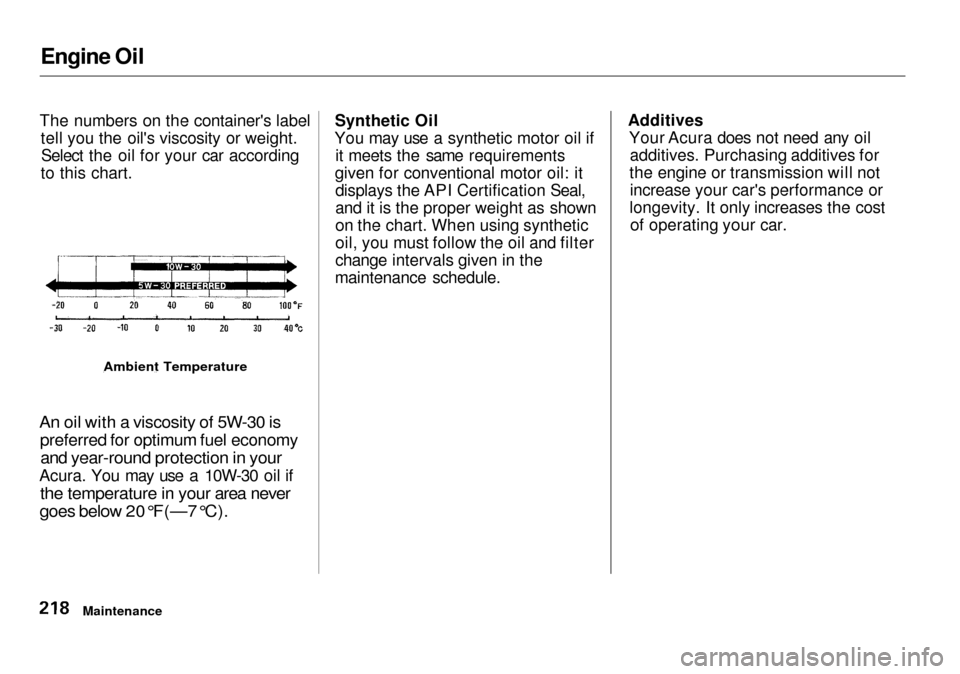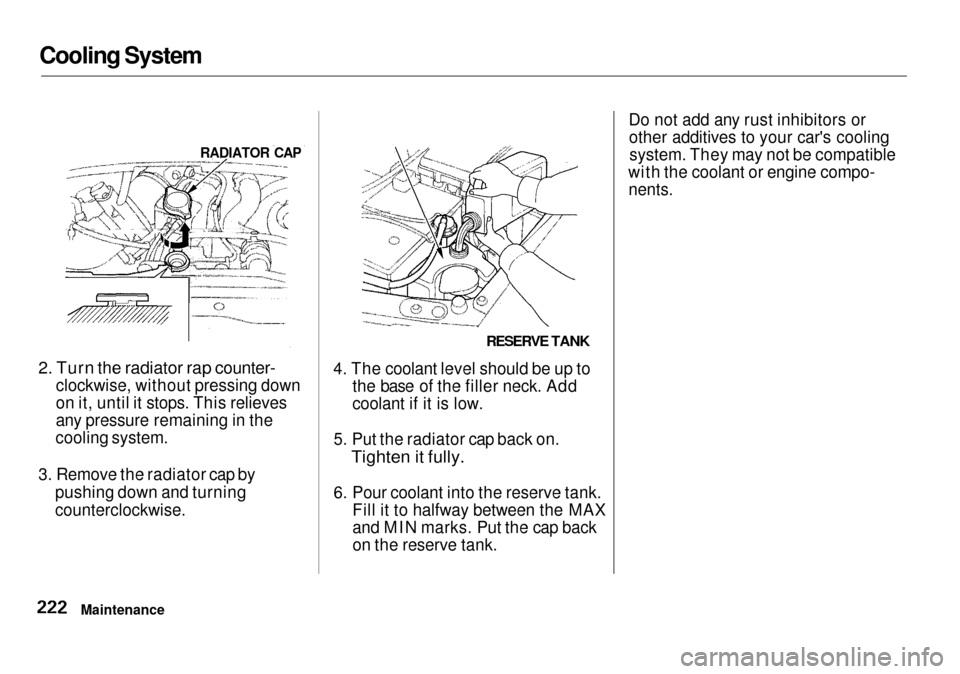Acura RL 2001 3.5 Owner's Manual
Manufacturer: ACURA, Model Year: 2001, Model line: RL, Model: Acura RL 2001Pages: 333, PDF Size: 4.28 MB
Page 221 of 333

Engine Oil
The numbers on the container's label tell you the oil's viscosity or weight.Select the oil for your car according
to this chart.
An oil with a viscosity of 5W-30 is
preferred for optimum fuel economy
and year-round protection in your
Acura. You may use a 10W-30 oil if
the temperature in your area never
goes below 20°F(—7°C).
Synthetic Oil
You may use a synthetic motor oil if it meets the same requirements
given for conventional motor oil: it displays the API Certification Seal,
and it is the proper weight as shown
on the chart. When using synthetic
oil, you must follow the oil and filter
change intervals given in the
maintenance schedule. Additives
Your Acura does not need any oiladditives. Purchasing additives for
the engine or transmission will not increase your car's performance or
longevity. It only increases the cost of operating your car.
Maintenance
Ambient Temperature
Page 222 of 333

Engine Oil
Changing the Oil and Filter
Always change the oil and filter according to the time and distance (miles/kilometers) recommenda-
tions in the maintenance schedule.
The oil and filter collect contami- nants that can damage your engine if
they are not removed regularly.
Changing the oil and filter requires
special tools and access from
underneath the car. The car should
be raised on a service station-type
hydraulic lift for this service. Unless
you have the knowledge and proper equipment, you should have this
maintenance done by a skilled
mechanic.
1. Run the engine until it reaches
normal operating temperature,
then shut it off.
2. Open the hood and remove the
engine oil fill cap. Remove the oil
drain bolt and washer from the
bottom of the engine. Drain the oil
into an appropriate container.
3. Remove the oil filter and let the
remaining oil drain. A special
wrench (available from your Acura
dealer) is required to remove the
filter.
CONTINUED
Maintenance
OIL DRAIN BOLT
WASHER
OIL FILTER
Page 223 of 333

Engine Oil
4. Install a new oil filter according to
instructions that come with it.
5. Put a new washer on the drain bolt,
then reinstall the drain bolt.
Tighten it to:
33 lbf.ft (44 N.m , 4.5 kgf.m)
6. Refill the engine with the recom-
mended oil.
Engine oil change capacity
(including filter):
4.9 US qt (4.6 , 4.0 Imp qt)
7. Replace the engine oil fill cap.
Start the engine. The oil pressure
indicator light should go out within
five seconds. If it does not, turn off
the engine and reinspect your
work.
8. Let the engine run for several
minutes and check the drain bolt
and oil filter for leaks.
9. Turn off the engine, let it sit for
several minutes, then check the oil
level. If necessary, add oil to bring the level to the upper mark on the
dipstick.
Improper disposal of engine oil can be
harmful to the environment. If you
change your own oil, please dispose ofthe used oil properly. Put it in a sealed
container and take it to a recycling center. Do not discard it in a trash bin
or dump it on the ground.
Maintenance
NOTICE
Page 224 of 333

Cooling System
Adding Engine Coolant
If the coolant level in the reserve
tank is at or below the MIN line, add
coolant to bring it up to the MAX line.
Inspect the cooling system for leaks.
This coolant should always be a mixture of 50 percent antifreeze and
50 percent water. Never add straight
antifreeze or plain water.
Always use Honda All Season
Antifreeze/Coolant Type 2. This coolant is pre-mixed with 50 percent
antifreeze and 50 percent water. It
does not require any additional
mixing.
If it is not available, you may use
another major-brand non-silicate
coolant as a temporary replacement.
Make sure it is a high-quality coolant
recommended for aluminum engines.
However, continued use of any non-
Honda coolant can result in
corrosion, causing the cooling system to malfunction or fail. Have
the cooling system flushed and
refilled with Honda antifreeze/ coolant as soon as possible.
If the reserve tank is completely
empty, you should also check the
coolant level in the radiator.
1. Make sure the engine and radiator
are cool.
CONTINUED
Maintenance
RESERVE TANK
Removing the radiator cap
while the engine is hot can cause the coolant to spray out,
seriously scalding you.
Always let the engine and radiator cool down before
removing the radiator cap.
Page 225 of 333

Cooling System
2. Turn the radiator rap counter-
clockwise, without pressing down
on it, until it stops. This relieves
any pressure remaining in the
cooling system.
3. Remove the radiator cap by pushing down and turning
counterclockwise. 4. The coolant level should be up to
the base of the filler neck. Add
coolant if it is low.
5. Put the radiator cap back on.
Tighten it fully.
6. Pour coolant into the reserve tank.
Fill it to halfway between the MAX
and MIN marks. Put the cap back
on the reserve tank.
Do not add any rust inhibitors or
other additives to your car's coolingsystem. They may not be compatible
with the coolant or engine compo- nents.
Maintenance RADIATOR CAP
RESERVE TANK
Page 226 of 333

Cooling System
Replacing Engine Coolant
The cooling system should be completely drained and refilled with
new coolant according to the time
and distance recommendations in
the maintenance schedule. Only use Honda All Season Antifreeze/Coolant Type 2. Use of any non-
Honda coolant or plain water can
result in corrosion and deposits in
the cooling system.
Draining the coolant requires access
to the underside of the car. Unless
you have the tools and knowledge,
you should have this maintenance done by a skilled mechanic.
1. Turn the ignition ON (II). Turn
the heater temperature control
dial to maximum heat (climate
control to 90°F/32°C). Turn off
the ignition. Open the hood. Make
sure the engine and radiator are
cool to the touch.
2. Remove the radiator cap.
3. Loosen the drain plug on the
bottom of the radiator. The
coolant will come out through the
hole in the splash cover.
CONTINUED
Maintenance
DRAIN PLUG
Page 227 of 333

Cooling System
4. On the right side of the engine
block, remove the clip with a plier, and then remove the drain cap.
5. Remove the reserve tank from its
holder by pulling it straight up.Drain the coolant, then put the
tank back in its holder.
6. When the coolant stops draining,
tighten the drain plug at the
bottom of the radiator.
Put the drain cap back in place
tightly, then reinstall the clip on
the drain cap securely.
Maintenance
CLIP
DRAIN CAP RESERVE TANK CAP
RESERVE TANK
HOLDER
Page 228 of 333

Cooling System
7. Remove the two bolts and the
three nuts with a 7/16 in (10 mm)
wrench, then remove the engine
cover.
8. Loosen the bleeder bolt on top of
the engine.
9. Pour Honda All Season
Antifreeze/Coolant Type 2 into the radiator up to the base of the
filler neck. This coolant is a
mixture of 50 percent antifreeze
and 50 percent water. Pre-mixing
is not required.
The cooling system capacity is:
1.61 US gal (6.1 , 1.34 Imp gal)
10.Tighten the bleeder bolt when
coolant comes out in a steady
stream with no bubbles.
CONTINUED
Maintenance
BOLTS
NUTS
BLEEDER BOLT
Page 229 of 333

Cooling System
11.Fill the reserve tank to the MAX
mark. Install the reserve tank cap.
12.Check the level in the radiator,
add coolant if needed.
13.Install the engine cover. First
tighten the two bolts on the front of the engine cover, then tighten
the three nuts on the engine cover.
Tightening torque:
7 lbf .
ft (10 N .
m , 1.0 kgf .
m)
14.Install the radiator cap, and
tighten it to the first stop.
15.Start the engine and let it run until
the radiator cooling fan comes on
at least twice. Then stop the
engine.
16.Remove the radiator cap. Pour
coolant into the. radiator up to the base of the filler neck and into the
reserve tank up to the MAX mark.
17.Start the engine and hold it at
1,500 rpm until the cooling fan comes on. Turn off the engine.
Check the coolant level in the
radiator and add coolant if needed.
18.Install the radiator cap, and
tighten it fully.
19.If necessary, fill the reserve tank
to the MAX mark. Install the
reserve tank cap.
Maintenance
Fill up to here
FILLER NECK
RESERVE TANK
Page 230 of 333

Windshield Washers
Check the level in the windshield
washer reservoir at least monthly during normal usage. In bad weather,
when you use the washers often, check the level every time you stop
for fuel.
The windshield washer reservoir is located behind the driver's side
headlight.
Check the reservoir's fluid level by
removing the cap and looking at the
float. It should be up to the top of the neck. If the float is at the bottom of
the neck, the reservoir is nearly
empty.
Fill the reservoir with a good-quality
windshield washer fluid. This increases the cleaning capability and
prevents freezing in cold weather.
Do not use engine antifreeze or a
vinegar/water solution in the
windshield washer reservoir.
Antifreeze can damage your ear's paint, while a vinegar/water solution can
damage the windshield washer pump.
Use only commercially-available
windshield washer fluid.
When you refill the reservoir, clean the edges of the windshield wiper
blades with windshield washer fluidon a clean cloth. This will help to
condition the blade edges.
Maintenance
FLOAT
NOTICE